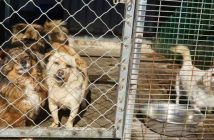Inner Mongolia
 The trek to Inner Mongolia may lead some travelers to question whether or not they are still in China. The flowing grasslands and desert expanses of this exotic land are a far cry from Beijing, and the capital city Hohhot offers exposure to mystic traditions and delicious cuisine. While organized tours are available in and around Hohhot, families with older children may want to visit more remote towns and villages. Spend a night in a traditional nomadic yurt and visit the mausoleum of Genghis Khan. Culture-seekers can soak up traditional Mongolian singing and dancing, while adventurers can try horse and camel riding. Due to the normally harsh climate in this part of the country, visiting between June and September is recommended.
The trek to Inner Mongolia may lead some travelers to question whether or not they are still in China. The flowing grasslands and desert expanses of this exotic land are a far cry from Beijing, and the capital city Hohhot offers exposure to mystic traditions and delicious cuisine. While organized tours are available in and around Hohhot, families with older children may want to visit more remote towns and villages. Spend a night in a traditional nomadic yurt and visit the mausoleum of Genghis Khan. Culture-seekers can soak up traditional Mongolian singing and dancing, while adventurers can try horse and camel riding. Due to the normally harsh climate in this part of the country, visiting between June and September is recommended.
The Route: Experience Mongolia’s magnificent landscape from a four-wheel drive (4WD) vehicle. Drive north via Fengning, then past Duolun, where only 4WD vehicles can venture. The truly adventurous can continue north through the southern reaches of the Gobi desert. A regular car is also fine, providing you don’t plan to go off the beaten track or into the desert. Brush up on your vehicle knowledge, and be sure to carry spare parts as well as a manual.
Camping Out: A pop-up tent that fits snugly on your 4WD roof is ideal, though a regular camping tent is also fine. Camping out may not suit those accustomed to comfort, but it does offer the breathtaking experience of sleeping under the stars. Remember: Stock up on food, water and toilet paper, good-quality sleeping bags, torches and a lamp. Local restaurants serve very basic fare, which includes mutton jiaozi and yak meat in strong and fibrous stews.
Sight to Remember: The serenity of the landscape – with nothing but the breeze in your hair, the hills on your horizon and a happy kid running across the Mongolian plains, chasing meandering cattle as he goes.
Getting There: One-hour flight from Beijing.
Tibet
 At 3,600 meters above sea level, nestled in the Himalayan Mountains, Lhasa is one of the highest cities in the world. Its name means "place of the gods" and its remote snowcapped mountains make it a pristine, peaceful destination indeed. Spiritual sites of interest include the sacred Potala Palace, Johkang – the holiest place in Tibet – and Norbulingka. Home of the Dalai Lamas, Potala Palace lies in the center of Kyichu Valley, which divides Lhasa’s new and old towns. Norbulingka, or Jewel Park, is a stunning palace that was once the summer home to the 7th and 8th Dalai Lama. Its gardens are ideal for outdoor picnics and it plays host to various theater events and festivals. In August, people camp out for days in Norbulingka to celebrate Sho Dun, or the Yoghurt Festival. During the festival, tourists can expect to see traditional dancing and bonfires. While this trip is not recommended for young children, Tibet is a great country to explore for elementary and high school kids. A sense of adventure is a must.
At 3,600 meters above sea level, nestled in the Himalayan Mountains, Lhasa is one of the highest cities in the world. Its name means "place of the gods" and its remote snowcapped mountains make it a pristine, peaceful destination indeed. Spiritual sites of interest include the sacred Potala Palace, Johkang – the holiest place in Tibet – and Norbulingka. Home of the Dalai Lamas, Potala Palace lies in the center of Kyichu Valley, which divides Lhasa’s new and old towns. Norbulingka, or Jewel Park, is a stunning palace that was once the summer home to the 7th and 8th Dalai Lama. Its gardens are ideal for outdoor picnics and it plays host to various theater events and festivals. In August, people camp out for days in Norbulingka to celebrate Sho Dun, or the Yoghurt Festival. During the festival, tourists can expect to see traditional dancing and bonfires. While this trip is not recommended for young children, Tibet is a great country to explore for elementary and high school kids. A sense of adventure is a must.
Where to Stay: The Sheraton Hotel has friendly and helpful English-speaking staff. While there is no playground or pool, there is a nice outdoor patio. The central location is within walking distance of the old Tibetan part of town. Connecting rooms are a great option for families and the hotel has special discounts on meals for children.
Kid-Friendly Site: Children will love the zoo at Norbulingka. It originally housed animals that were given to the Dalai Lama and has recently adopted a snow leopard. Head to the Ganden Monastery, where lucky guests can befriend locals and get a taste of yak butter tea.
Travel Tips: Having a bilingual guide is helpful and will enrich your trip. If you take the train, beware of mediocre food and leaking toilets.
Getting there: 24-hour train ride from Xining or a five-hour flight from Beijing via Chengdu.
Chengdu
 No stay in China is complete without a glimpse at the country’s most treasured animal, the giant panda, and Chengdu is just the place to do it. These magnificent creatures are becoming increasingly rare, so an opportunity to hold a baby panda would be an experience that the little ones will never forget.
No stay in China is complete without a glimpse at the country’s most treasured animal, the giant panda, and Chengdu is just the place to do it. These magnificent creatures are becoming increasingly rare, so an opportunity to hold a baby panda would be an experience that the little ones will never forget.
Though pandas may be Chengdu’s biggest draw, the city itself has a lot to offer. This hub of Sichuan is much easier on the eyes than most of China’s more populous cities and is filled with charming side streets and restaurants serving delicious local cuisine. Numerous temple parks will impress with their green spaces, bamboo forests and Taoist pavilions.
Panda Experience: Visit the Chengdu Research Base of Giant Panda Breeding (www.panda.org.cn). If you want assured panda interaction, travel to the Wolong Panda Research Station (www.pandaclub.cn), located 138km from Chengdu, but expect to pay a bit more.
Where to Hike: Try the hike up Qingcheng Mountain, which passes Taoist temples and wonderful views (the trek features many steps, so younger children may need to be carried). Stop at the restaurant for lunch, then take a ferry across the lake located a third of the way up the mountain (www.qcs.cn).
What to Eat: As the capital of Sichuan province, Chengdu is an ideal place to sample some of the country’s best hot pot (dishes can be adjusted for spiciness at most restaurants).
Getting There: Two hour and 40 minute flight from Beijing.
Don’t forget to check out Part 2 of this post.



